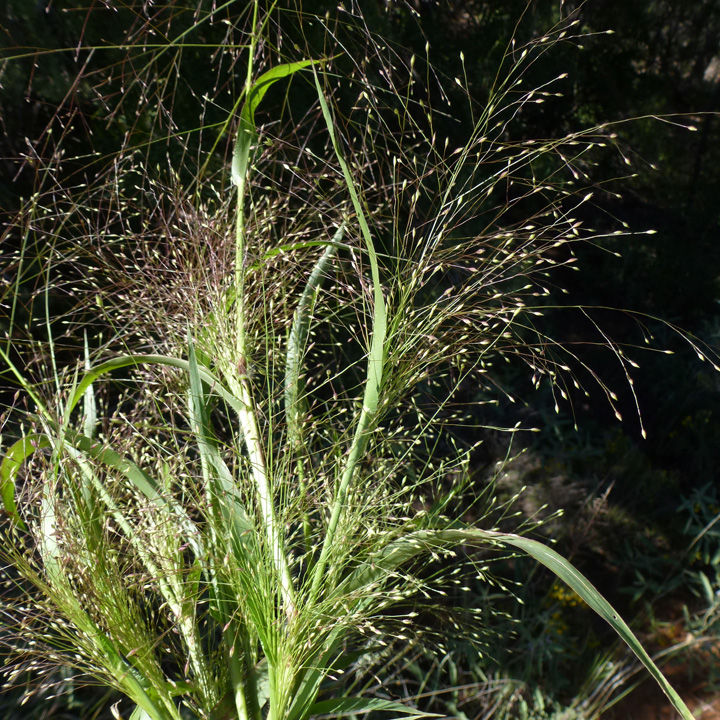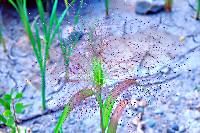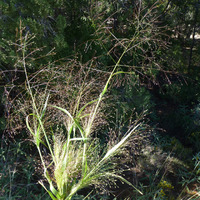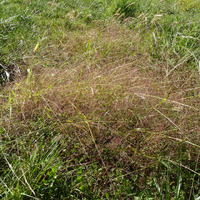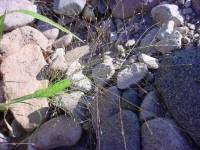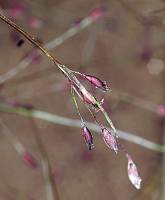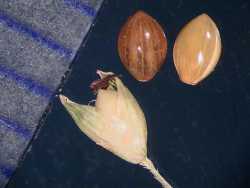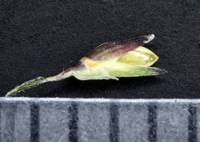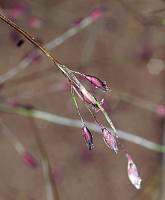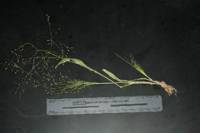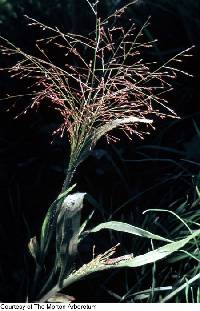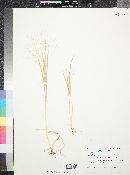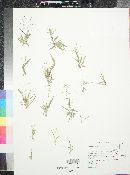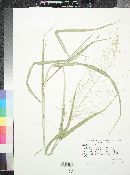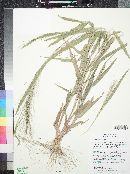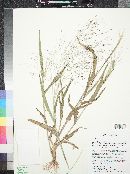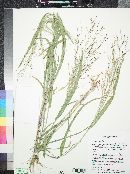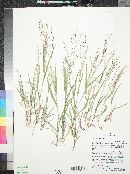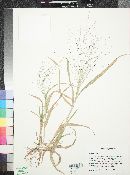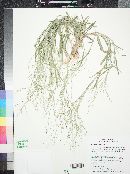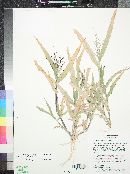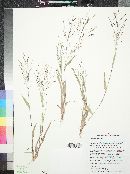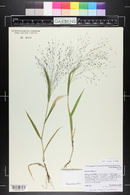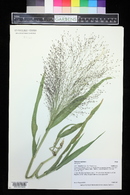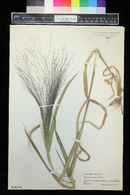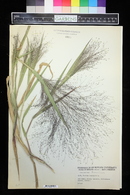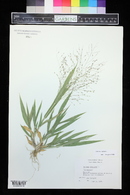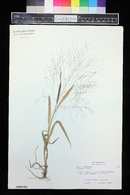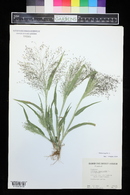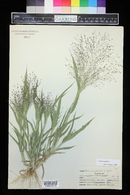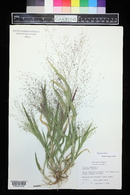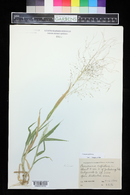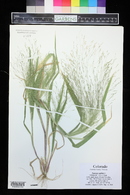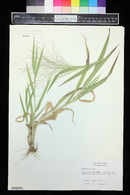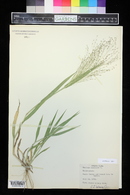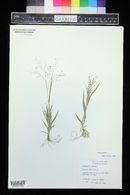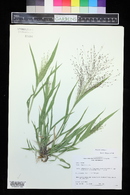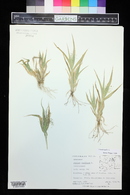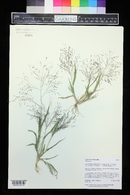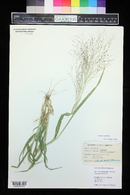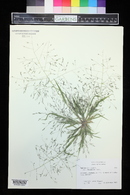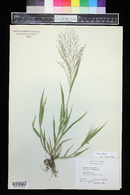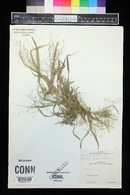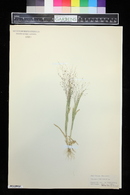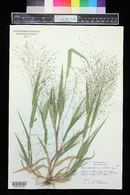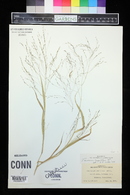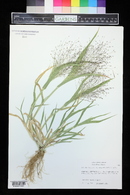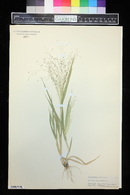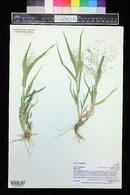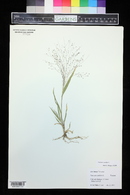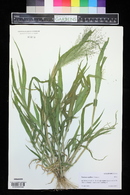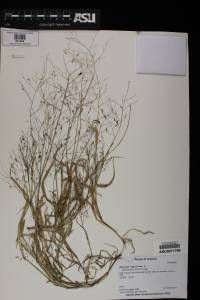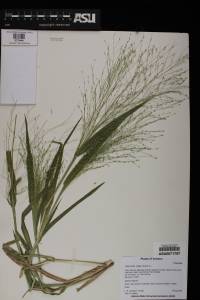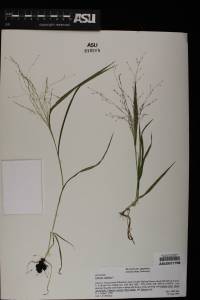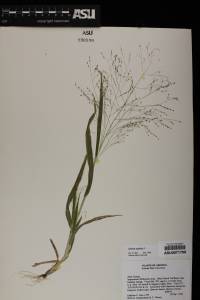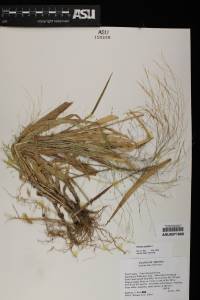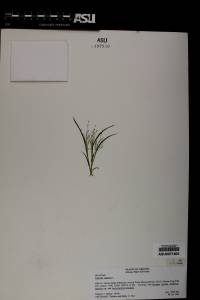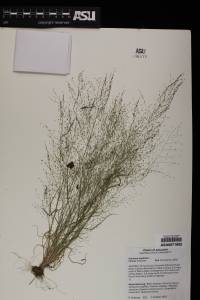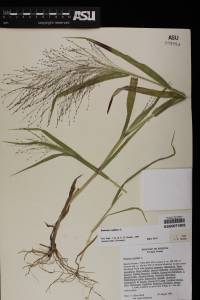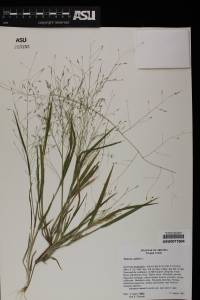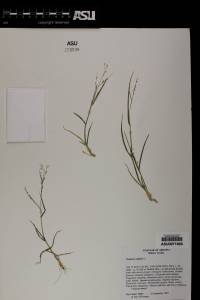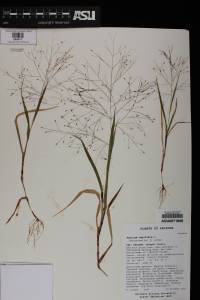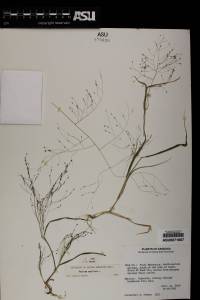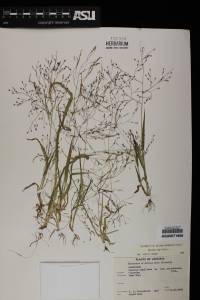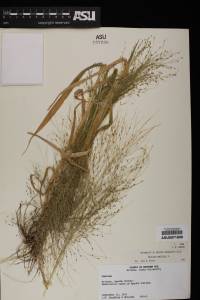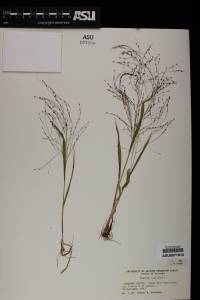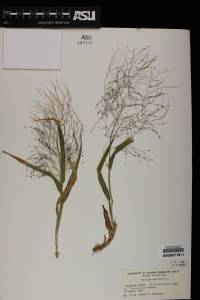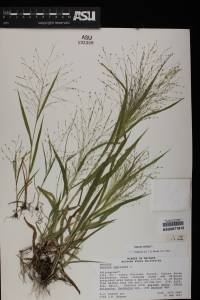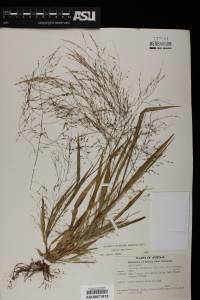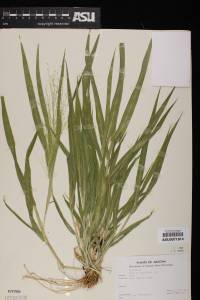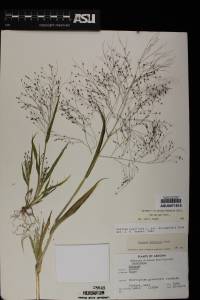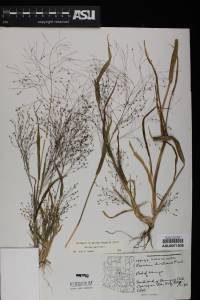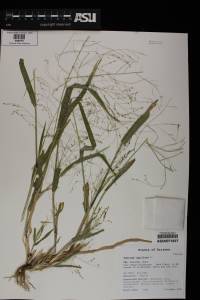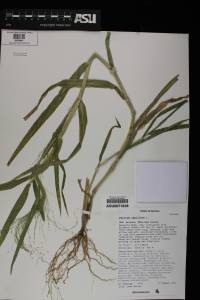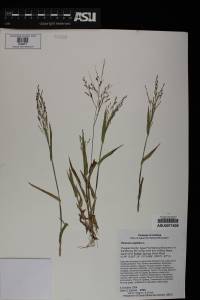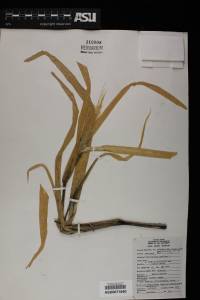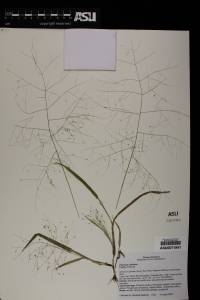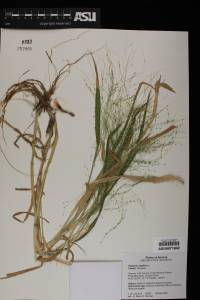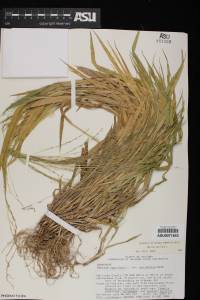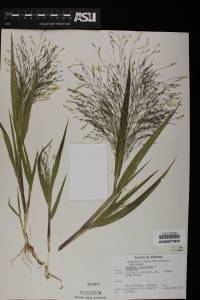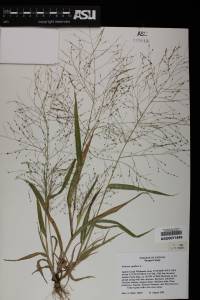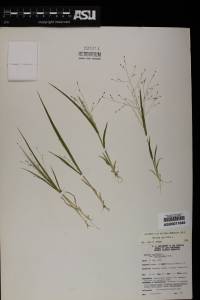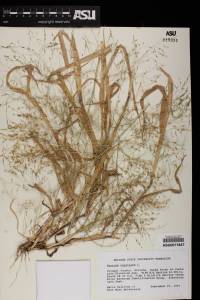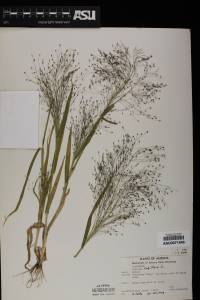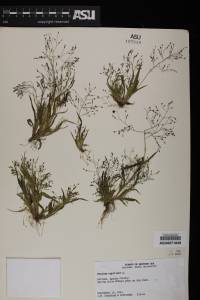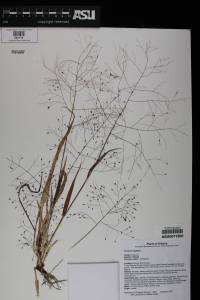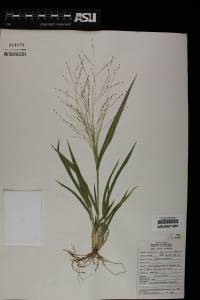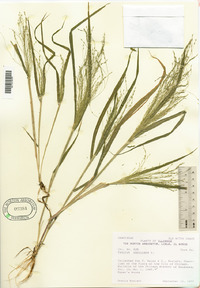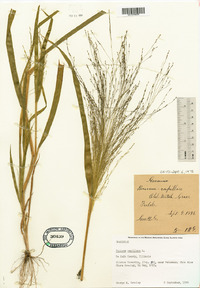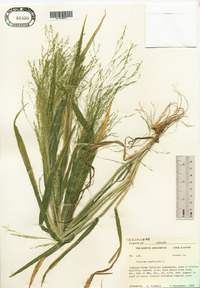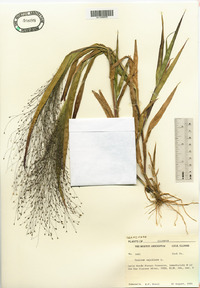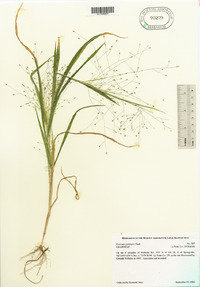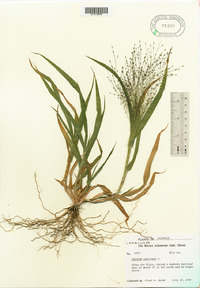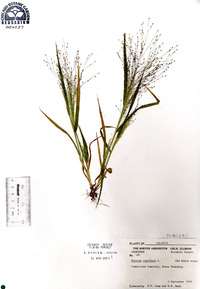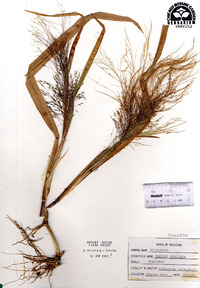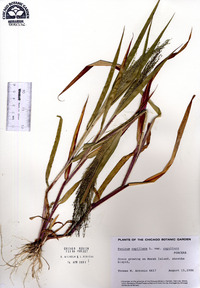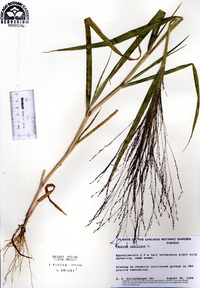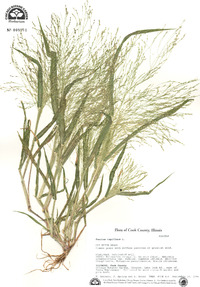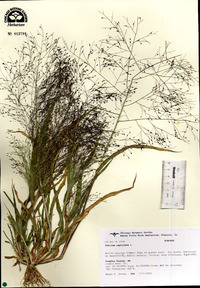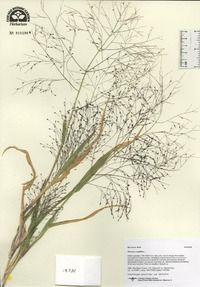
|
|
|
|
Family: Poaceae
Common Panic Grass, more...annual witchgrass, common witchgrass, panicgrass, ticklegrass, tumble panic, tumbleweed grass, witches hair, witchgrass, Panic Capillaire
[Leptoloma barbipulvinata (Nash) Smyth, moreLeptoloma capillaris (L.) Smyth, Milium barbipulvinatum (Nash) Lunell, Milium capillare (L.) Moench, Panicum barbipulvinatum Nash, Panicum barbipulvinatum var. hirsutipes Suksd., Panicum bobarti Lam., Panicum capillare subsp. barbipulvinatum (Nash) Tzvelev, Panicum capillare var. agreste Gattinger, Panicum capillare var. barbipulvinatum (Nash) R.L. McGregor, Panicum capillare var. brevifolium Vasey ex Rydb. & Shear, Panicum capillare var. occidentale Rydb., Panicum capillare var. vulgare Scribn., Panicum elegantulum Suksd.] |
Plants annual; hirsute or hispid, hairs papillose-based, often bluish or purplish. Culms 15-130 cm, slender to stout, not woody, erect to decumbent, straight to zigzag, simple to profusely branched; nodes sparsely to densely pilose. Sheaths rounded, hirsute or hispid, hairs papillose-based; ligules membranous, ciliate, cilia 0.5-1.5 mm; blades 5-40 cm long, 3-18 mm wide, linear, spreading. Panicles 13-50 cm long, 7-24 cm wide, usually more than 1/2 as long as the plants, included at the base or exserted at maturity, disarticulating at the base of the peduncles at maturity and becoming a tumbleweed; branches spreading; pedicels 0.5-2.8 mm, scabrous, pilose. Spikelets 1.9-4 mm, ellipsoid to lanceoloid, often red-purple, glabrous. Lower florets sterile; lower glumes 1/3-1/2 as long as the spikelets, 1-3-veined; upper glumes 1.8-3.1 mm, 7-9-veined, midveins scabridulous; lower lemmas 1.9-3 mm, extending 0.4-1.1 mm beyond the upper florets, often stiff, straight, prominently veined distally; upper florets stramineous or nigrescent, sometimes with a prominent lunate scar at the base, often disarticulating before the glumes, leaving the empty glumes and lower lemmas temporarily persisting on the panicles. 2n = 18. Panicum capillare grows in open areas, particularly in disturbed sites such as fields, pastures, roadsides, waste places, ditches, sand, rock crevices, etc. It grows throughout temperate North America, including northern Mexico. It also grows in Bermuda, the Virgin Islands, and sporadically in South America, and has become naturalized in much of Europe and Asia. It appears to hybridize with P. philadelphicum. Annual herb 15 cm - 1.3 m tall Leaves: alternate, two-ranked. Sheaths rounded, with bumpy-based hairs. Ligules membranous, fringed with hairs (hairs 0.5 - 1.5 mm long). Blades spreading, 5 - 40 cm long, 3 - 18 mm wide, linear, parallel-veined. Inflorescence: a branched arrangement of spikelets (panicle), lax, diffuse, 13 cm - 0.5 m long, 7 - 24 cm wide, usually over half as long as the plant, breaking off at maturity and becoming a tumbleweed. Fruit: a caryopsis, indehiscent, enclosed within the persistent lemma and palea. Culm: upright or decumbent, stout to slender, zigzag to straight, unbranched to branched, 15 cm - 1.3 m long, round in cross-section, and hairy. Nodes sparsely to densely soft-hairy. Spikelets: often reddish purple, 2 - 4 mm long, lance-shaped to ellipsoid. Glumes: unequal, herbaceous. Lower glumes one-third to one-half as long as spikelets, one- to three-veined. Upper glumes 1.5 - 3 mm long, seven- to nine-veined, with minutely rough midveins. Lemmas:: Lower lemmas similar to upper glumes, stiff, straight, 2 - 3 mm long, prominently veined towards the apex. Upper lemmas shiny, with rolled-up margins on the upper surface. Paleas:: Lower paleas present or absent. Upper paleas longitudinally lined. Florets:: Lower florets sterile. Upper florets bisexual, pointed at the apex. Anthers three. Stigmas red. Similar species: No information at this time. Flowering: mid-July to late October Habitat and ecology: Open, disturbed areas. Occurence in the Chicago region: native Etymology: Panicum comes from the Latin word panis, meaning bread, or panus, meaning "ear of millet." Capillare means hair-like. Author: The Morton Arboretum FNA 2007; Gould 1988 Common Name: witchgrass Duration: Annual Nativity: Native Lifeform: Graminoid General: Tufted annual grass; stems erect to decumbent, mostly 20-80 cm long, usually much-branched and decumbent at base, less frequently erect and little branched; herbage hirsute or hispid, often bluish or purplish; pubescent at least at nodes. Vegetative: Ligule of stiff hairs 1-1.5 mm long, connate and membranous below; blades flat or folded, 5-40 cm long, 3-18 mm wide, sparsely papillose-pilose, sometimes ciliate; sheaths rounded, hirsute or hispid, the hairs papillose-based. Inflorescence: Panicles 10-30 cm long, diffuse, divaricately spreading, nearly as broad as long and including half the length of entire plant, with long, capillary branches and pedicels; disarticulating at the base of the peduncles at maturity and becoming a tumbleweed. Spikelets 2-4 mm, ellipsoid to lanceoloid, often red-purple, glabrous, 2-flowered, the first floret reduced to a sterile lemma and the second floret bisexual with an indurate lemma. Ecology: Found in moist soil, waste places, open spaces, and cultivated ground from 2,000-7,000 ft (610-2134 m); flowers June-September. Distribution: Throughout the US, s CAN, and MEX; south to S. Amer; introduced in Australia. Notes: The genus Panicum is defined as having unawned spikelets with 2 florets, the first floret sterile or staminate, and the second floret bisexual with a rigid lemma that clasps the palea. This species is a hardy, hairy annual grass, growing in spreading tufts from 16-20 inches high, the tufts being then covered with large pyramidal panicles of graceful airy form, purplish in color. It grows in any soil, often sows itself, and is suited for borders or beds being one of the most graceful of grasses. Several related species were formerly classified as subspecies of P. capillare; true P. capillare is set apart from those by its long pedicels, 8-20 mm long, which gently curve and are not stiff and straight; the panicle diffusely branched and usually at least half the height of the plant; the first glume half the length of the spikelet; and spikelets about 3 mm long. Ethnobotany: Seed is cooked whole or ground into a powder and used as a flour. It is often mixed with corn. The seed is very small and fiddly to use. It has a mild flavor and can be used like millet. Etymology: Panicum is a classical Latin name for millet, while capillare means hair-like, referring to the panicle branches. Synonyms: Panicum barbipulvinatum, P. capillare var. agreste, P. capillare var. barbipulvinatum, P. capillare subsp. barbipulvinatum, P. capillare var. brevifolium, P. capillare var. occidentale Editor: SBuckley 2010, AHazelton 2015 Coarse, rough-hairy annual to 7 dm, branched from the base, erect or ascending or in depauperate forms spreading; lvs 6-17 mm wide; panicles diffusely branched, sometimes two-thirds as long as the whole plant; axillary pulvini glabrous to evidently hairy; spikelets all or mostly on long pedicels, acute to acuminate, 1.8-3.5 mm, the first glume a third to half as long as the sterile lemma; fr stramineous, 1.4-2 mm, a third as wide; margins of the lemma distinctly inrolled, the visible part of the palea a third to half as wide as the fr; 2n=18. Dry or moist soil, often a weed in fields and gardens, widespread throughout most of the U.S. and s. Can. (P. barbipulvinatum; P. gattingeri) Gleason, Henry A. & Cronquist, Arthur J. 1991. Manual of vascular plants of northeastern United States and adjacent Canada. lxxv + 910 pp. ©The New York Botanical Garden. All rights reserved. Used by permission. From Flora of Indiana (1940) by Charles C. Deam A pernicious weed in all parts of the state in all kinds of soils and in all kinds of habitats except in dense woodland. It shows great variation in size and form, depending upon how much it is crowded in growing. In dried-up ponds where it germinates late, mature plants may be only a few inches high. …… Indiana Coefficient of Conservatism: C = 0 Wetland Indicator Status: FAC Indiana populations belong to subsp. capillare. |
|
|
|
This project was made possible in part by the Institute of Museum and Library Services [MG-70-19-0057-19].
Powered by Symbiota

